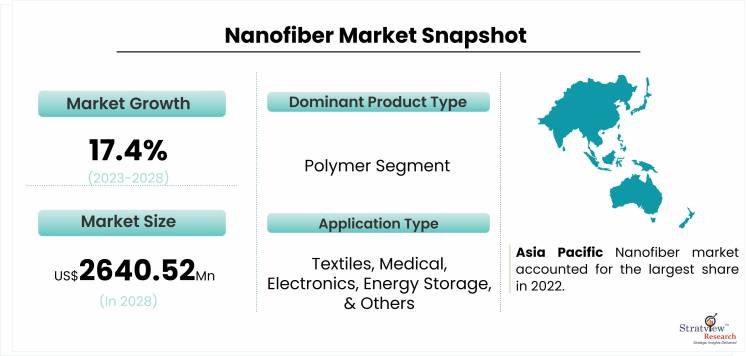Nanofiber Market Growth: Opportunities and Innovations Shaping the Industry

The nanofiber market is witnessing significant growth as industries worldwide recognize the unique properties and vast potential of nanofibers. These ultra-thin fibers, with diameters measured in nanometers, offer superior strength, high surface area, and remarkable mechanical and electrical properties. As demand rises across various sectors, including healthcare, energy, and filtration, the nanofiber market is poised for substantial expansion. This article explores the key opportunities and innovations driving growth in the nanofiber industry.
According to Stratview Research, the nanofiber market was estimated at USD 914.55 million in 2022 and is likely to grow at a CAGR of 17.4% during 2023-2028 to reach USD 2640.52 million in 2028.
Opportunities in the Nanofiber Market
- Healthcare and Biomedical Applications
The healthcare sector represents one of the most promising opportunities for nanofibers. Nanofibers are increasingly used in advanced medical applications such as tissue engineering, wound dressings, and drug delivery systems. Their high porosity and ability to mimic the extracellular matrix make them ideal for supporting cell growth and facilitating controlled drug release. The potential for nanofibers to revolutionize regenerative medicine and improve patient outcomes is driving significant investments in this area.
- Environmental Protection and Filtration
Nanofibers are becoming a critical component in air and water filtration systems, offering enhanced filtration efficiency for capturing pollutants, bacteria, and viruses. The growing focus on environmental sustainability and the need for cleaner air and water are fueling demand for nanofiber-based filters. From industrial filtration systems to personal protective equipment (PPE), nanofibers are providing solutions that meet increasingly stringent regulatory standards. This trend creates vast opportunities for manufacturers specializing in nanofiber-based filtration products.
- Energy Storage and Renewable Energy
As the world transitions toward renewable energy, nanofibers are playing a crucial role in the development of high-performance energy storage solutions. Nanofibers are used in batteries, supercapacitors, and fuel cells to enhance energy density, conductivity, and charge-discharge cycles. With the rapid growth of the electric vehicle (EV) market and the increasing adoption of renewable energy sources, the demand for advanced energy storage technologies is accelerating. Nanofiber innovations in this space offer opportunities for substantial market growth.
Innovations Shaping the Industry
- Electrospinning and Other Manufacturing Techniques
The production of nanofibers has been revolutionized by advancements in manufacturing techniques such as electrospinning, which allows for the precise control of fiber diameter and morphology. These innovations are improving the scalability, cost-effectiveness, and quality of nanofiber production. As manufacturing technologies continue to advance, nanofibers are becoming more accessible to a broader range of industries, unlocking new applications and markets.
- Sustainability and Green Nanofibers
Sustainability is an emerging trend in the nanofiber industry, with a growing focus on developing bio-based and eco-friendly nanofibers. Natural polymers such as cellulose, silk, and chitosan are being explored as sustainable alternatives to synthetic materials. Green nanofibers offer the dual benefit of reducing environmental impact while maintaining high performance. As companies seek to align with global sustainability goals, the demand for green nanofibers is expected to grow.
- Nanofibers in Smart Textiles
Innovations in smart textiles represent another exciting frontier for nanofibers. Integrating nanofibers into fabrics allows for the development of clothing and materials with advanced functionalities, such as temperature regulation, moisture management, and even health monitoring capabilities. The growing interest in wearable technology is driving research and innovation in this area, opening up new markets for nanofiber applications.
Conclusion
The nanofiber market is positioned for rapid growth as opportunities in healthcare, environmental protection, energy storage, and smart textiles continue to expand. Innovations in production techniques and sustainable materials are further propelling the industry forward, offering new avenues for market development. As industries embrace the transformative potential of nanofibers, the future of the nanofiber market looks bright, with continued innovation and growth on the horizon.
- Industry
- Art
- Causes
- Crafts
- Dance
- Drinks
- Film
- Fitness
- Food
- Games
- Gardening
- Health
- Home
- Literature
- Music
- Networking
- Other
- Party
- Religion
- Shopping
- Sports
- Theater
- Wellness
- News


